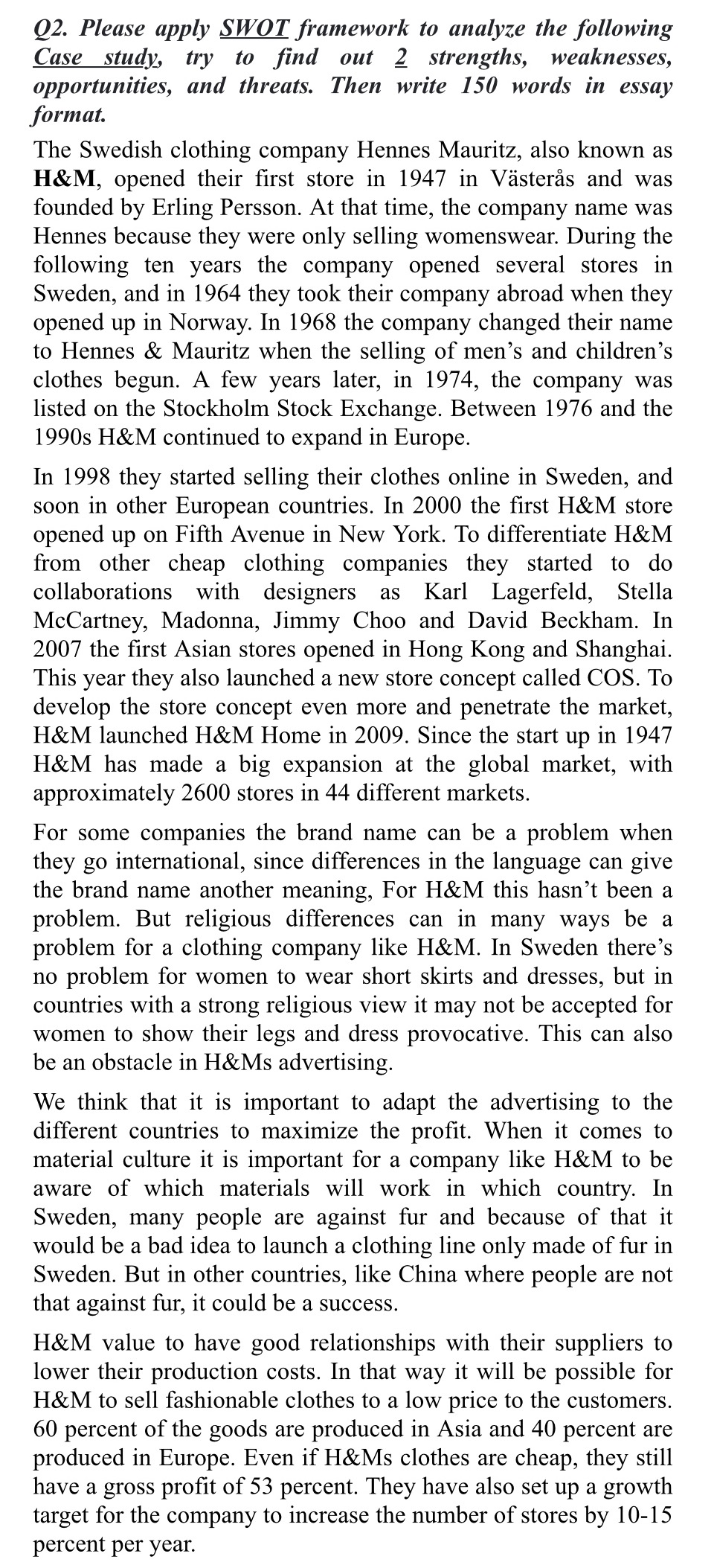Question
Q2. Please apply SWOT framework to analyze the following Case study, try to find out 2 strengths, weaknesses, opportunities, and threats. Then write 150 words
Q2. Please apply SWOT framework to analyze the following Case study, try to find out 2 strengths, weaknesses, opportunities, and threats. Then write 150 words in essay format.The Swedish clothing company Hennes Mauritz, also known as H&M, opened their first store in 1947 in Vsters and was founded by Erling Persson. At that time, the company name was Hennes because they were only selling womenswear. During the following ten years the company opened several stores in Sweden, and in 1964 they took their company abroad when they opened up in Norway. In 1968 the company changed their name to Hennes & Mauritz when the selling of men's and children's clothes begun. A few years later, in 1974, the company was listed on the Stockholm Stock Exchange. Between 1976 and the 1990s H&M continued to expand in Europe.In 1998 they started selling their clothes online in Sweden, and soon in other European countries. In 2000 the first H&M store opened up on Fifth Avenue in New York. To differentiate H&M from other cheap clothing companies they started to do collaborations with designers as Karl Lagerfeld, Stella McCartney, Madonna, Jimmy Choo and David Beckham. In 2007 the first Asian stores opened in Hong Kong and Shanghai. This year they also launched a new store concept called COS. To develop the store concept even more and penetrate the market, H&M launched H&M Home in 2009. Since the start up in 1947 H&M has made a big expansion at the global market, with approximately 2600 stores in 44 different markets.For some companies the brand name can be a problem when they go international, since differences in the language can give the brand name another meaning, For H&M this hasn't been a problem. But religious differences can in many ways be a problem for a clothing company like H&M. In Sweden there's no problem for women to wear short skirts and dresses, but in countries with a strong religious view it may not be accepted for women to show their legs and dress provocative. This can also be an obstacle in H&Ms advertising.We think that it is important to adapt the advertising to the different countries to maximize the profit. When it comes to material culture it is important for a company like H&M to be aware of which materials will work in which country. In Sweden, many people are against fur and because of that it would be a bad idea to launch a clothing line only made of fur in Sweden. But in other countries, like China where people are not that against fur, it could be a success.H&M value to have good relationships with their suppliers to lower their production costs. In that way it will be possible for H&M to sell fashionable clothes to a low price to the customers. 60 percent of the goods are produced in Asia and 40 percent are produced in Europe. Even if H&Ms clothes are cheap, they still have a gross profit of 53 percent. They have also set up a growth target for the company to increase the number of stores by 10-15 percent per year.

Step by Step Solution
There are 3 Steps involved in it
Step: 1

Get Instant Access to Expert-Tailored Solutions
See step-by-step solutions with expert insights and AI powered tools for academic success
Step: 2

Step: 3

Ace Your Homework with AI
Get the answers you need in no time with our AI-driven, step-by-step assistance
Get Started


